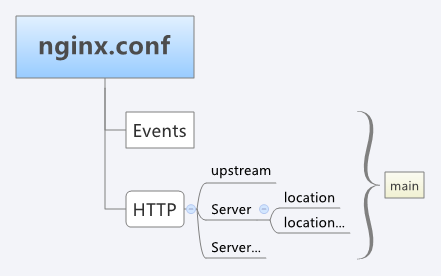前言
新书Java并发编程系统与模型已上线,欢迎拜读。
由于微信小程序要使用Https,但是又不能修改已有线上的配置。所以最简单的方法就是使用nginx转发,在nginx上使用https,然后再转发到内部服务器。Nginx由于其优良的性能。一台4核16GB的内存完全可以支撑日均百万pv级别的访问。
基础知识
Nginx由于使用了 epoll模型,要求linux的内核必须在2.6以上。要了解epoll模型,可以看看知乎上的这篇文章IO多路复用与 select,poll与epoll的关系。
使用 uname -a 查看Linux 内核版本,如下是Centos 6.5的显示:
Linux VM_26_145_centos 2.6.32-504.30.3.el6.x86_64 #1 SMP Wed Jul 15 10:13:09 UTC 2015 x86_64 x86_64 x86_64 GNU/Linux下载
Nginx 的官网的下载地址:nginx.org/en/download…
Nginx官网提供了三个类型的版本:
- Mainline version:Mainline 是 Nginx 目前主力在做的版本,可以说是开发版
- Stable version:最新稳定版,生产环境上建议使用的版本
- Legacy versions:遗留的老版本的稳定版
编译与安装
nginx依赖以下模块:
- gzip模块需要 zlib 库 及其开发环境
- rewrite模块需要 pcre 库及开发环境
- ssl 功能需要openssl库及开发环境以及 yum install -y gcc-c++ 环境。
以gzip 模块为例,查看以下模块是否安装:
rpm -qa |grep zlib 如果没有安装,那么就 yum install zlib zlib-devel。
make是用来编译的,它从Makefile中读取指令,然后编译。make install是用来安装的,它也从Makefile中读取指令,安装到指定的位置。
最简单的编译安装 Nginx
tar zxvf nginx-1.10.2.tar.gz
解压以后进入到
[root@VM_26_145_centos nginx-1.10.2]# ./configure
[root@VM_26_145_centos nginx-1.10.2]# make
[root@VM_26_145_centos nginx-1.10.2]# make install./configure 是用来检查本机的的安装环境。在configure阶段结束以后,将会出现如下信息:
Configuration summary
+ using system PCRE library
+ OpenSSL library is not used
+ md5: using system crypto library
+ sha1: using system crypto library
+ using system zlib library
nginx path prefix: "/usr/local/nginx"
nginx binary file: "/usr/local/nginx/sbin/nginx"
nginx configuration prefix: "/usr/local/nginx/conf"
nginx configuration file: "/usr/local/nginx/conf/nginx.conf"
nginx pid file: "/usr/local/nginx/logs/nginx.pid"
nginx error log file: "/usr/local/nginx/logs/error.log"
nginx http access log file: "/usr/local/nginx/logs/access.log"
nginx http client request body temporary files: "client_body_temp"
nginx http proxy temporary files: "proxy_temp"
nginx http fastcgi temporary files: "fastcgi_temp"
nginx http uwsgi temporary files: "uwsgi_temp"
nginx http scgi temporary files: "scgi_temp"可以看到默认的安装目录以及一些基本的配置。
启动
nginx默认采用80端口,在直接启动nginx之前,先检查80端口是否被占用,使用fuser -n tcp 80或者netstat -pan | grep :80查看80端口是否被占用。这里假设没有被占用,然后进入 /usr/local/nginx(上文提到的默认安装目录)目录:
[root@VM_26_145_centos nginx]# sbin/nginx -c conf/nginx.conf访问:http://ip:80/就可以看到nginx的欢迎页面。
nginx配置
在/usr/local/nginx/conf(默认配置)中,有一个nginx.conf文件。nginx.conf的代码是这样的:
# user nobody;
worker_processes 1;
#error_log logs/error.log;
#error_log logs/error.log notice;
#error_log logs/error.log info;
#pid logs/nginx.pid;
events {
worker_connections 1024;
}
http {
include mime.types;
default_type application/octet-stream;
#log_format main '$remote_addr - $remote_user [$time_local] "$request" '
# '$status $body_bytes_sent "$http_referer" '
# '"$http_user_agent" "$http_x_forwarded_for"';
#access_log logs/access.log main;
sendfile on;
#tcp_nopush on;
#keepalive_timeout 0;
keepalive_timeout 65;
#gzip on;
server {
listen 80;
server_name localhost;
#charset koi8-r;
#access_log logs/host.access.log main;
location / {
root html;
index index.html index.htm;
}
#error_page 404 /404.html;
# redirect server error pages to the static page /50x.html
#
error_page 500 502 503 504 /50x.html;
location = /50x.html {
root html;
}
# proxy the PHP scripts to Apache listening on 127.0.0.1:80
#
#location ~ \.php$ {
# proxy_pass http://127.0.0.1;
#}
# pass the PHP scripts to FastCGI server listening on 127.0.0.1:9000
#
#location ~ \.php$ {
# root html;
# fastcgi_pass 127.0.0.1:9000;
# fastcgi_index index.php;
# fastcgi_param SCRIPT_FILENAME /scripts$fastcgi_script_name;
# include fastcgi_params;
#}
# deny access to .htaccess files, if Apache's document root
# concurs with nginx's one
#
#location ~ /\.ht {
# deny all;
#}
}
# another virtual host using mix of IP-, name-, and port-based configuration
#
#server {
# listen 8000;
# listen somename:8080;
# server_name somename alias another.alias;
# location / {
# root html;
# index index.html index.htm;
# }
#}
# HTTPS server
#
#server {
# listen 443 ssl;
# server_name localhost;
# ssl_certificate cert.pem;
# ssl_certificate_key cert.key;
# ssl_session_cache shared:SSL:1m;
# ssl_session_timeout 5m;
# ssl_ciphers HIGH:!aNULL:!MD5;
# ssl_prefer_server_ciphers on;
# location / {
# root html;
# index index.html index.htm;
# }
#}
}删掉不必要的文件,基本文件类型是这个样子:
# user nobody;
worker_processes 1;
#error_log logs/error.log;
#error_log logs/error.log notice;
#error_log logs/error.log info;
#pid logs/nginx.pid;
events {
worker_connections 1024;
}
http {
include mime.types;
default_type application/octet-stream;
#log_format main '$remote_addr - $remote_user [$time_local] "$request" '
# '$status $body_bytes_sent "$http_referer" '
# '"$http_user_agent" "$http_x_forwarded_for"';
#access_log logs/access.log main;
sendfile on;
#tcp_nopush on;
#keepalive_timeout 0;
keepalive_timeout 65;
#gzip on;
server {
listen 80;
server_name localhost;
#charset koi8-r;
#access_log logs/host.access.log main;
location / {
root html;
index index.html index.htm;
}
}
}注意到最顶上的日志配置吗?在顶部设置的配置全局生效。但是子模块可以覆盖它。顶部日志配置:
error_log /disk/nginx/logs/error.log;
accsess_log 去掉 mian 。 main 表示的用户自定义的日志格式的名字。 目前并没有设置。假设开发人员改变了nginx.conf配置,测试nginx.conf是否合法:
[root@VM_220_53_centos nginx]# sbin/nginx -t -c conf/nginx.conf
nginx: the configuration file /usr/local/nginx/conf/nginx.conf syntax is ok
nginx: configuration file /usr/local/nginx/conf/nginx.conf test is successfulnginx配置文件架构的图:

这里有详细的配置。
###https
在编译阶段需要附带编译上ssl模块:./configure --with-http_ssl_module
限流
limit_req_zone $binary_remote_addr zone=perip:10m rate=1r/s;
limit_req_zone $server_name zone=perserver:10m rate=10r/s;
server {
...
limit_req zone=perip burst=5 nodelay;
limit_req zone=perserver burst=10;
} 注意在Http中配置以后需要在server中引入。
burst一秒中可以访问的数据量。burst相当于一个授权令牌,每秒中每次查询,当前burst-1,查询结束,burst+1;
如果burst为0时,访问不了。
public class TestNginx {
@Test
public void testMobileIsUsed() {
for (int i = 0; i < 100; i++) {
HttpResponse response = HttpRequest.get("http://123.206.18.37:8088/").send();
if (response.statusCode() != 200) {
assertEquals(1, 0);
}
System.out.println(response.bodyText());
}
}
}可以看到,基本上是1秒返回一次了。
实例配置:
#user nobody;
worker_processes 1;
error_log /disk/nginx/logs/error.log;
#error_log logs/error.log notice;
#error_log logs/error.log info;
pid logs/nginx.pid;
events {
worker_connections 2048;
}
http {
include mime.types;
default_type application/octet-stream;
access_log /disk/nginx/logs/host.access.log;
sendfile on;
#tcp_nopush on;
#keepalive_timeout 0;
keepalive_timeout 65;
#gzip on;
limit_req_zone $binary_remote_addr zone=perip:10m rate=1r/s;
limit_req_zone $server_name zone=perserver:10m rate=10r/s;
# HTTPS server
server {
limit_req zone=perip burst=5 nodelay;//限流配置
limit_req zone=perserver burst=10;
listen 443;
server_name mp.baidu.com;
ssl on;
ssl_certificate 1_mp.baidu.com_bundle.crt;
ssl_certificate_key 2_mp.baidu.com.key;
ssl_session_timeout 5m;
ssl_protocols TLSv1 TLSv1.1 TLSv1.2;
ssl_ciphers ECDHE-RSA-AES128-GCM-SHA256:HIGH:!aNULL:!MD5:!RC4:!DHE;
ssl_prefer_server_ciphers on;
location / {
root html;
index index.html index.htm;
proxy_pass http://10.105.26.210; //直接转发
}
}
}